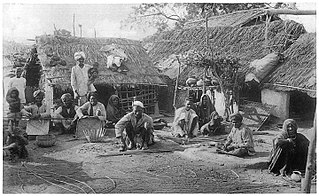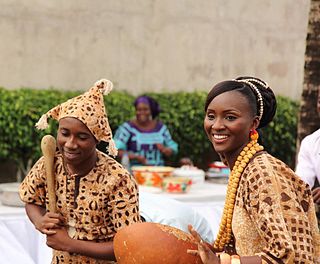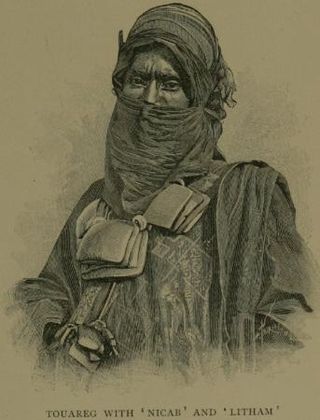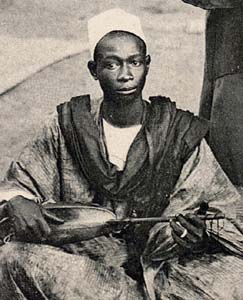
Caste is a form of social stratification characterised by endogamy, hereditary transmission of a style of life which often includes an occupation, ritual status in a hierarchy, and customary social interaction and exclusion based on cultural notions of purity and pollution. Its paradigmatic ethnographic example is the division of India's Hindu society into rigid social groups, with roots in south Asia's ancient history and persisting to the present time. However, the economic significance of the caste system in India has been declining as a result of urbanisation and affirmative action programs. A subject of much scholarship by sociologists and anthropologists, the Hindu caste system is sometimes used as an analogical basis for the study of caste-like social divisions existing outside Hinduism and India. The term "caste" is also applied to morphological groupings in eusocial insects such as ants, bees, and termites.

The Senufo people, also known as Siena, Senefo, Sene, Senoufo, and Syénambélé, are a West African ethnolinguistic group. They consist of diverse subgroups living in a region spanning the northern Ivory Coast, the southeastern Mali and the western Burkina Faso. One sub-group, the Nafana, is found in north-western Ghana.

The Tuareg people are a large Berber ethnic group that principally inhabit the Sahara in a vast area stretching from far southwestern Libya to southern Algeria, Niger, Mali, and Burkina Faso. Traditionally nomadic pastoralists, small groups of Tuareg are also found in northern Nigeria.

The Tuareg languages constitute a group of closely related Berber languages and dialects. They are spoken by the Tuareg Berbers in large parts of Mali, Niger, Algeria, Libya and Burkina Faso, with a few speakers, the Kinnin, in Chad.

The Songhai Empire was a state that dominated the western Sahel/Sudan in the 15th and 16th century. At its peak, it was one of the largest states in African history. The state is known by its historiographical name, derived from its leading ethnic group and ruling elite, the Songhai. Sonni Ali established Gao as the capital of the empire although a Songhai state had existed in and around Gao since the 11th century. Other important cities in the empire were Timbuktu and Djenné, conquered in 1468 and 1475 respectively, where urban-centered trade flourished and to the south is the north Akan state of Bonoman. Initially, the empire was ruled by the Sonni dynasty, but it was later replaced by the Askia dynasty (1493–1901).

The Songhai people, Hausa : mutanen sonhay, zabarmawa, dendawa, Gaoborori, Tuareg languages : ihatan(ayneha), izabarmane, Arabic languages : zabarmawi, Mande : koroboro are ethnolinguistic group in West Africa who speak the various Songhai languages. Their history and lingua franca is linked to the Songhai Empire which dominated the western Sahel in the 15th and 16th century. Predominantly a Muslim community, the Songhai are found primarily throughout Niger and Mali in the Western sudanic region. The name Songhai was historically neither an ethnic nor linguistic designation, but a name for the ruling caste of the Songhay Empire which are the Songhai proper of sunni and Askya dynasty found predominantly in present-Niger. However, the correct term used to refer to this group of people collectively by the natives is "Ayneha". Although some Speakers in Mali have also adopted the name Songhay as an ethnic designation, other Songhay-speaking groups identify themselves by other ethnic terms such as Zarma or Isawaghen. The dialect of Koyraboro Senni spoken in Gao is unintelligible to speakers of the Zarma dialect of Niger, according to at least one report. The Songhay languages are commonly taken to be Nilo-Saharan but this classification remains controversial. Nicolai considers the songhay languages as a afro-asiatic Berber subgroup or a new subgroup of semitic languages restructured under Mande and nilo Saharan influence, the lexicon of songhay languages includes many completes lexical fields close to Berbers languages, old and new semitic, northern songhay speakers are Berbers from Tuareg people : Dimmendaal (2008) believes that for now it is best considered an independent language family.

The Tukulor people, also called Toucouleur or Haalpulaar, are a West African ethnic group native to Futa Tooro region of Senegal. There are smaller communities in Mali and Mauritania. The Toucouleur were Islamized in the 11th century; their early and strong Islamic heritage, which is seen as a defining feature, is a "matter of great pride for them". They have been influential in the spread of Islam to West Africa in the medieval era, later founded the vast Toucouleur Empire in the 19th century under Omar Saidou Tall that led a religious war against their neighboring ethnic groups and the French colonial forces.

The Toubou or Tubu are an ethnic group native to the Tibesti Mountains that inhabit the central Sahara in northern Chad, southern Libya and northeastern Niger. They live either as herders and nomads or as farmers near oases. Their society is clan-based, with each clan having certain oases, pastures and wells.

The Wolof people are a West African ethnic group found in northwestern Senegal, the Gambia, and southwestern coastal Mauritania. In Senegal, the Wolof are the largest ethnic group (~43.3%), while elsewhere they are a minority. They refer to themselves as Wolof and speak the Wolof language, in the West Atlantic branch of the Niger–Congo family of languages.

The Iwellemmedan (Iwəlləmədǎn), also spelled Iullemmeden, Aulliminden, Ouilliminden, Lullemmeden, and Iwellemmeden, are one of the seven major Tuareg tribal or clan confederations. Their communities are historically nomadic and intermixed with other ethnic groups. The Iwellemmeden inhabit a wide area ranging from east and north central Mali, through the Azawagh valley, into northwestern Niger and south into northern Nigeria. While once a single confederation of dozens of Tuareg clans, subject peoples, and allied groups, since the 18th century they have been divided into Kel Ataram (west) and Kel Dinnik (east) confederations. Following colonial rule and independence, the Iwellemmedan homelands cross the Mali/Niger border, and their traditional seasonal migration routes have spread Iwellemmedan communities into Burkina Faso and Nigeria as well. They speak the Tawellemmet variant of the Tamasheq language, although some current or historical sub-clans speak other Tamasheq variants as well as Songhai languages and Arabic dialects.
Caste systems in Africa are a form of social stratification found in numerous ethnic groups, found in over fifteen countries, particularly in the Sahel, West Africa, and North Africa. These caste systems feature endogamy, hierarchical status, inherited occupation, membership by birth, pollution concepts and restraints on commensality.

The Zarma people are an ethnic group predominantly found in westernmost Niger. They are also found in significant numbers in the adjacent areas of Nigeria and Benin, along with smaller numbers in Burkina Faso, Ivory Coast, Ghana, Togo, and Sudan. In Niger, the Zarma are often considered by outsiders to be of the same ethnicity as the neighboring Songhai proper, although the two groups claim differences, having different histories and speaking different dialects. They are sometimes lumped together as the Zarma-Songhay or Songhay-Zarma.

Hamallayya or Hamallism is a Sufi ṭarīqah originating in West Africa as an outgrowth from and reaction against the Tijaniyyah brotherhood. It was founded at the beginning of the 20th century by a mystic Muhammad ben Amadu of Maure and Fulani background, as reform movement of Tijaniyyah practice. Stressing opposition to hierarchy and downplaying the importance of education, the movement spread in the 1920s by Amadu's disciple Shaykh Hamahullah bin Muhammad bin Umar (1886–1943) in what was then French Soudan, modern Mali. It first took root amongst Wolof traders living in Nioro, but soon spread to servile caste Muslims in Mauretania and Mali.
The Ikelan are a caste within Tuareg society, who were at one time slaves or servile communities.
The Jakhanke -- also spelled Jahanka, Jahanke, Jahanque, Jahonque, Diakkanke, Diakhanga, Diakhango, Dyakanke, Diakhanké, Diakanké, or Diakhankesare -- are a Manding-speaking ethnic group in the Senegambia region, often classified as a subgroup of the larger Soninke. The Jakhanke have historically constituted a specialized caste of professional Muslim clerics (ulema) and educators. They are centered on one larger group in Guinea, with smaller populations in the eastern region of The Gambia, Senegal, and in Mali near the Guinean border. Although generally considered a branch of the Soninke, their language is closer to Western Manding languages such as Mandinka.
The Dawsahak people, Idaksahak are pastoralist Berbers centered on Ménaka and Inékar town in Menaka Cercle and Talataye in Ansongo Cercle of the Gao Region of northeastern Mali. They speak the Northern Songhai language Tadaksahak. Many also speak Western Tawallammat Tamajaq language, the Tuareg language of southern Gao. Daoussahak appears to be the most common transliteration of the collective name among French and English academics.
The Igdalen are a Berber people inhabiting northwestern Niger and parts of Mali and Algeria. They speak Tagdal, a mixed Tuareg–Songhay language. The Igdalen are closely related to Idaksahak people of eastern Mali and the Sawaq of Ingal in Niger, with whom they share a very similar language. Culturally, the Igdalen are often considered a Tuareg faction. In the past they have formed a sub-confederation with the Kel Fadey, Kel Ferwan and others in the Kel Ayr Tuareg confederation or Drum Group.

Slavery in Mali exists today, with as many as 200,000 people held in direct servitude to a master. Since 2006, a movement called Temedt has been active in Mali struggling against the persistence of slavery and the discrimination associated with ex-slaves. There were reports that in the Tuareg Rebellion of 2012, ex-slaves were recaptured by their former masters. Moreover, the phenomenon of descent-based slavery still persist in different ethnic groups.

The Nyamakala, or Nyamakalaw, are the historic occupational castes among Islamic societies of West Africa, particularly among the Mandinka people. The Nyamakala are known as Nyaxamalo among the Soninke people, and Nyenyo among the Wolof people. They are found throughout the Sahel region, from Mali and Senegal to Chad and several other parts of the West African region historically known as the "Western Sudan".

The Songhai proper are an ethnic group in the northwestern corner of Niger's Tillaberi Region, an area historically known in the country as Songhai. They are a subgroup of the broader Songhai group. Even though the Songhais have so much in common with the Zarma, to the extent that some Songhais may refer to themselves and their dialect as "Zarma," both see themselves as two distinct branches of the same ethnicity.















